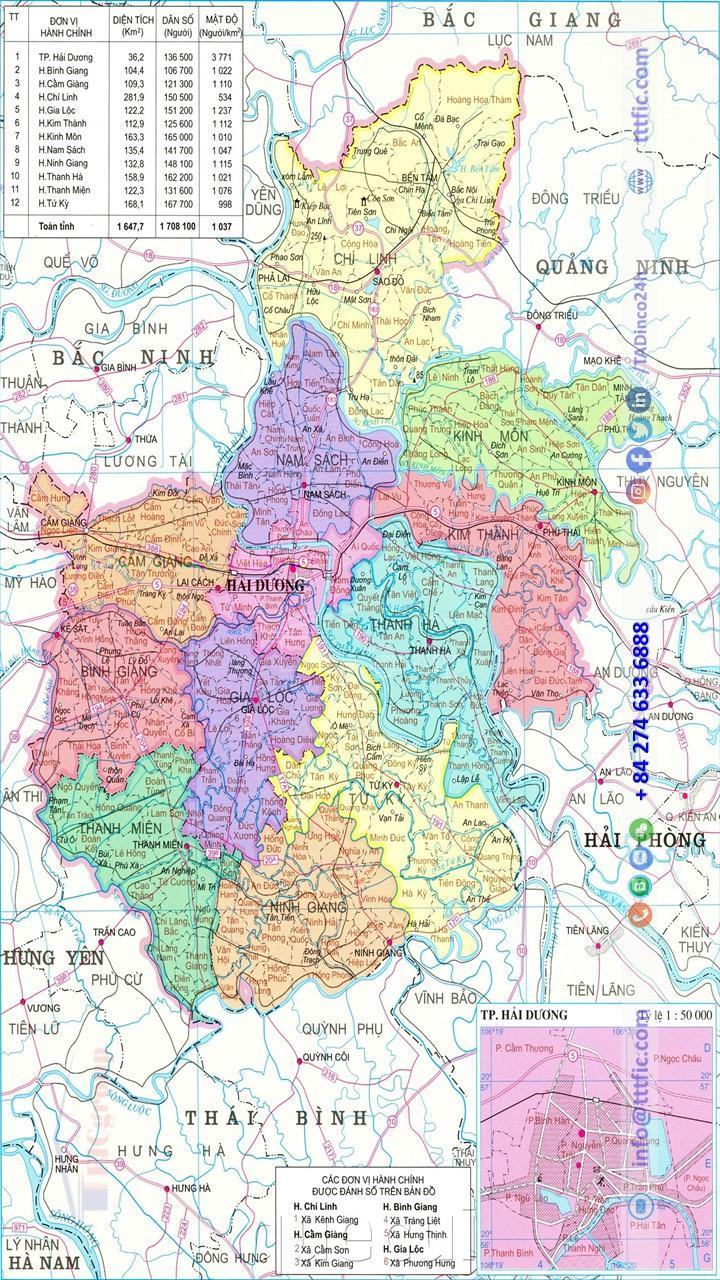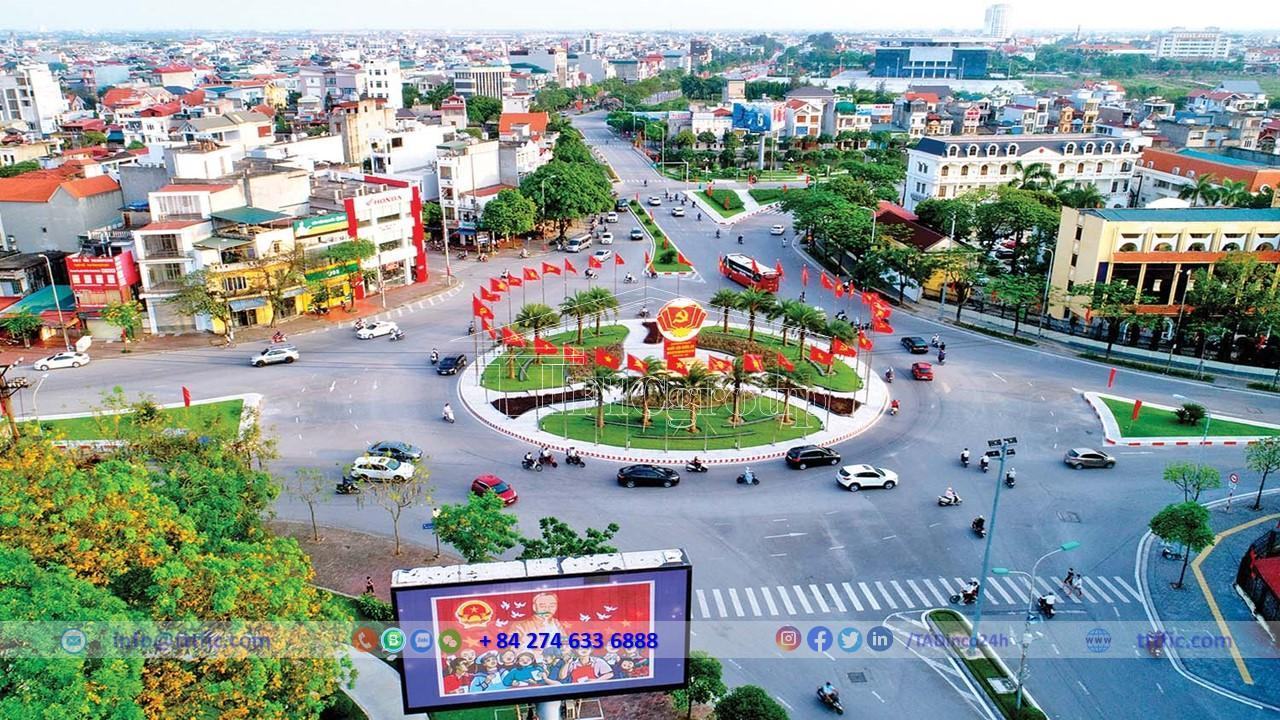Hai Duong Province:
Hai Duong province, a province in Vietnam’s Red River Delta, holds the eighth highest population in the country in 2021, totaling 1,936,774 residents. With an impressive GDP growth rate of 8.5%, the province’s Gross Regional Domestic Product (GRDP) reached 149,700 billion Vietnamese dong (equivalent to 6,480 billion USD). The per capita GRDP stood at 77 million Vietnamese dong (equivalent to 3,347 USD).
As a vital part of northern Vietnam’s key economic region, Hải Dương plays a central role. Hải Dương City, the capital of the province and a first-class urban area, strategically lies 57 km east of Hanoi and 45 km west of Hải Phòng.
In accordance with the 2007 planning, Hải Dương lies within the capital region and serves as a significant industrial hub for the entire area .
Geography of Hai Duong province:
Geographical location:
Hải Dương, a province situated in the Red River Delta, extends from 20°43′ to 21°14′ North latitude and 106°03′ to 106°38′ East longitude.
The provincial capital, Hải Dương City, is located approximately 57 km west of the central capital city Hanoi and about 45 km east of the central city Hải Phòng. Geographically, Hải Dương shares borders with:
- To the North: Bắc Giang province.
- To the East: Quảng Ninh province and Hải Phòng city.
- To the West: Bắc Ninh province and Hưng Yên province.
- To the South: Thái Bình province.
The extreme points of Hải Dương province are as follows:
- The northernmost point is in Hoàng Hoa Thám commune, Chí Linh City.
- The westernmost point is in Cẩm Hưng commune, Cẩm Giàng district.
- The easternmost point is in Minh Tân ward, Kinh Môn town.
- The southernmost point is in Hồng Phong commune, Thanh Miện district.
Topographic:
Hải Dương, an average-sized province in Vietnam, covers an area of 1,662 km² and is partitioned into two regions. The hilly region, located in the province’s north, includes Chí Linh City and Kinh Môn town, covering about 11% of the area. These low hills are suitable for growing fruit, timber, and short-term industrial crops. The remaining 89% is the fertile delta region formed by the Thái Bình River’s sediment. It offers ideal alluvial soil for cultivating various crops, resulting in multiple harvests each year.

Climate:
Hải Dương is located in a subtropical humid climate zone, characterized by distinct four seasons (spring, summer, autumn, winter).
During the transition period from early February to early April, known as the spring to clear and bright season, there are occurrences of drizzle and mist, marking the shift from the dry season to the rainy season. The rainy season typically lasts from May to September each year.
The average annual rainfall ranges from 1,300 to 1,700 mm. The northern districts in the province receive less rainfall, below 1,500 mm, due to the obstructing terrain of the Đông Triều and Kinh Môn mountain ranges. The northern region of Hải Dương, along with the eastern areas of Bắc Giang and Lạng Sơn provinces, and Cao Bằng province, are wind-sheltered regions in the summer, receiving less moisture. As a result, the average annual rainfall is lower compared to other places in the northern region. Hải Dương City experiences the lowest average annual rainfall among the cities in the Red River Delta.
The average temperature is 23.3 °C. The number of sunny days ranges from 1,600 to 1,750 hours per year, with higher values in the northern districts gradually decreasing towards the southern ones.
The average relative humidity ranges from 85% to 87%.
The favorable climate is conducive to agricultural production, including cereal crops, food crops, and fruit trees, particularly for winter vegetable cultivation.
Natural resource:
The main mineral resources in Hải Dương province include:
– Limestone for cement production in Kinh Môn, with reserves of 200 million tons and a CaCO3 content ranging from 90% to 97%. This is sufficient for producing 4 to 5 million tons of cement per year for a period of 50 to 70 years.
– Kaolin in Kinh Môn and Chí Linh, with reserves of 400,000 tons. It has an Fe2O3 content of 0.8% to 1.7% and an Al2O3 content of 17% to 19%. It serves as a raw material for ceramic production.
– Fire-resistant clay in Chí Linh, with reserves of 8 million tons and good quality. It has an Al2O3 content of 23.5% to 28% and an Fe2O3 content of 1.2% to 1.9%. It provides raw materials for manufacturing fire-resistant bricks.
– Bauxite in Kinh Môn, with reserves of 200,000 tons. It has an Al2O3 content ranging from 46.9% to 52.4%, Fe2O3 content from 21% to 26.6%, and SiO2 content from 6.4% to 8.9%.
Economy:
Estimated economic growth in Hải Dương province in 2022 reached 9.0%, ranking 27th out of 63 provinces nationwide and 8th out of 11 in the Red River Delta region (Hanoi 8.89%, Ninh Binh 8.62%, Bac Ninh 7.39%). The growth in agriculture, forestry, and fisheries (AFF) was 3.4%, while the industrial and construction sector grew by 11.8% (industry +12.0%, construction +9.8%). The service sector experienced a growth of 7.7%, and tax and subsidy on products increased by 3.1%.
Contributing to the overall growth rate of 9.0%, the AFF sector contributed 0.35 percentage points, while the industrial and construction sector contributed 6.29 percentage points (industry 5.78 percentage points, construction 0.51 percentage points). The service sector contributed 2.08 percentage points, and tax and subsidy on products contributed 0.28 percentage points.
Agriculture, forestry, aquaculture:
Agriculture:
Annual Crops:
The total cultivated area for annual crops in 2022 was 151,967 hectares, showing a 0.4% decrease compared to the previous year. Rice, the main crop, accounted for 72.2% of the total cultivated area, with both the area and yield experiencing a decrease. Despite that, vegetable cultivation witnessed a 1.9% increase, whereas the overall yield for most vegetable types declined compared to the previous year.
Perennial Crops:
The province experienced a slight 0.4% increase in the total cultivated area for perennial crops in 2022, reaching 22,482 hectares. Silk cotton trees were the predominant crop; however, their cultivation area decreased due to low productivity. Conversely, other fruits such as lychee, mango, banana, and guava demonstrated an increase in production compared to the previous year.
Livestock:
In 2022, there was an effective restoration and expansion of pig farming, resulting in a significant increase in the total number of pigs and meat production. Poultry farming also displayed substantial growth, characterized by stable flocks and an augmented meat production. Furthermore, there was an increase in the number of buffaloes and cattle, leading to higher meat production for both species.
Overall, livestock production experienced growth, particularly in pig and poultry farming, while crop production yielded mixed results, with a decrease in rice yield but an increase in some fruit varieties.

Forestry:
The forest planting and care movement in Hải Dương province consistently maintained and developed in 2022. The newly planted forest area, totaling 130 hectares, mainly consisted of the production forests that were exploited in 2021 and early 2022. Throughout recent years, all levels and sectors have prioritized the work of forest protection and development. The province estimated that 592 hectares of planted forests were well-maintained, marking a 19-hectare increase compared to the previous year. Of these, 72 hectares were state-managed planted forests, while the remaining belonged to individual households’ rubber plantations. The contracted forest protection area amounted to 5,940 hectares, primarily comprising protective forests and special-use forests.
In 2022, the timber extraction from planted forests and scattered plantations recorded an approximate volume of 7,550 cubic meters, representing a 51.8% increase compared to the previous year. Additionally, the production of firewood reached an estimated 54,855 steres, indicating a 4.4% increase from the previous year. The firewood primarily originated from cutting branches, harvesting grass, flashing, and collection during the timber exploitation of scattered plantations.
Aquaculture:
In 2022, the preliminary output of aquatic products amounted to 97,119 tons, marking a 6.1% increase (+5,559 tons) compared to the previous year. Specifically, aquaculture production reached 95,277 tons, reflecting a 6.3% growth. Fish constituted the majority, accounting for 95,188 tons, representing 99.9% of the total aquaculture output and experiencing a 6.3% rise compared to the preceding year.
The maintenance and significant development of the cage aquaculture method were notable. The preliminary total output of caged fish in 2022 reached 21,913 tons, contributing to 23.0% of the overall aquaculture production and demonstrating a 15.3% increase (+2,907 tons) compared to the corresponding period in 2021. The remarkable surge in caged fish production can be attributed to favorable year-long weather conditions, stable water flow, facilitating optimal fish growth, and minimal disease outbreaks.
Overall, aquaculture has maintained stability with a substantial increase in output this year. The strong advancement of cage fish farming is driven by its high economic efficiency. There has been an active shift towards improved fish breeds with superior meat quality and higher market value, replacing traditional fish breeds of lower worth.
Industry:
In 2022, the overall industrial production index reached 111.3% compared to the same period. Although industrial production grew at a slower pace than the previous year, the processing and manufacturing industries showed significant growth, indicating a strong recovery of the fundamental industries after the pandemic. However, the growth momentum decreased towards the end of 2022 (Q1 +23.9%, Q2 +10.2%, Q3 +9.2%, estimated Q4 +5.9%), signaling challenges for 2023. Here is an overview of the production situation in some important industries in the province:
Electronic component manufacturing sector
The electronic component manufacturing sector (accounting for 14.6% of the province’s total industrial production) achieved a production index of 118.3% in 2022 compared to the same period. Integrated circuits reached 110.2%, other electronic components not yet specified reached 120.9%, and multi-function machines such as printers, faxes, and copiers reached 125.5%. The growth can be attributed to the recovery of both domestic and global markets, as well as the increasing demand for electronic components. Additionally, due to the tightening of COVID-19 prevention measures in countries such as China, Taiwan, South Korea, and Japan, many manufacturing orders have shifted to Vietnam.
Motor vehicle manufacturing sector
The motor vehicle manufacturing sector (accounting for 12.4% of the province’s total industrial production) achieved a production index of 113.6% in 2022 compared to the same period. Specifically, vehicles with engines capable of carrying five or more people reached 223.4%. The demand for transportation vehicles, particularly cars, has shown a clear recovery compared to the period of 2020-2021. Policies such as a 50% reduction in registration fees for domestically manufactured vehicles, coupled with credit support from banks, have encouraged continued consumer purchases and stimulated growth in the motor vehicle manufacturing industry and its supporting components. Furthermore, the production of two new models, Ford Ranger 2023 and Ford Territory 2023, by Ford Vietnam Co., Ltd. has significantly increased the volume of assembled vehicles and consumption.
Food processing and manufacturing sector
The food processing and manufacturing sector (primarily focusing on animal feed production, accounting for 8.2% of the province’s total industrial production) achieved a production index of 111.6% in 2022 compared to the same period. Animal feed production reached 112.8%. The stable development of the domestic livestock industry and effective control of diseases have ensured the production and consumption of animal feed. Additionally, the expansion of production scale by some enterprises has made a positive contribution to the growth of the sector.
Precast metal product manufacturing sector
The precast metal product manufacturing sector (accounting for 3.5% of the province’s total industrial production) is also experiencing significant growth, with a production index of 124.1% in 2022 compared to the same period. Although most businesses in this sector are small or micro-sized domestic enterprises, they constitute a large percentage, accounting for nearly 19% of the total industrial businesses. Therefore, the growth of this sector indicates that the businesses, which were initially heavily impacted by the pandemic, have recovered and adapted to the new conditions.

Textile, garment, and footwear sector
The textile, garment, and footwear sector (accounting for 11.7% of the province’s total industrial production) witnessed a decline in orders since mid-Q3. However, the overall production output for this sector in 2022 still recorded a significant increase compared to the same period, with growth rates of 116.1%, 111.2%, and 114.9% respectively. During the early months of the year, the sector’s export activities were boosted by effectively utilizing the advantages of new-generation Free Trade Agreements (FTAs). However, starting from mid-Q3, major markets such as the US and Europe have slowed down due to inflationary pressures, energy crises, and natural disasters, leading to tightened consumer spending. Many orders were canceled or postponed, significantly affecting businesses in the industry. It is forecasted that this situation will persist until Q3 2023.
Electricity production and distribution sector
In the electricity production and distribution sector (accounting for 5.0% of the province’s total industrial production), the production index in 2022 reached 110.0% compared to the same period. Due to weather conditions, water levels in hydroelectric reservoirs have been relatively abundant, ensuring stable electricity generation. Additionally, the domestic and global coal prices have increased, resulting in higher production costs for thermal power generation. Moreover, during the year, the Pha Lai Thermal Power Joint Stock Company encountered an unresolved issue in one of its production lines, while the Jack Hai Duong Power Company carried out its first scheduled maintenance, leading to difficulties in achieving the planned electricity production levels at the beginning of the year.
On the other hand, several manufacturing sectors are facing significant difficulties, resulting in low or negative growth rates, including:
Metal manufacturing sector:
The metal manufacturing sector (accounting for 19.0% of the province’s total industrial production) had a production index of 94.7% in 2022. In the final months of the year, the demand for metal weakened both domestically and globally. Additionally, the prices of raw materials, particularly coal (which tripled compared to normal times), tightened credit conditions, and sharp increases in exchange rates and interest rates, negatively impacted the operations of businesses in the industry.
Non-metallic mineral product manufacturing sector
The non-metallic mineral product manufacturing sector (primarily producing cement, clinker, accounting for 4.3% of the province’s total industrial production) recorded a production output of 100.5% in 2022 compared to the same period. Due to the construction market not recovering as expected in the final months of the year, the production volume remained stagnant.
Mining sector:
The mining sector had a production output of 81.4% in 2022 compared to the same period. Many mining areas had expired licenses, while the state policy restricted licensing for the exploitation and use of non-renewable resources, leading to a shortage of input materials. A significant number of businesses temporarily ceased operations, dissolved, or switched to other industries for production and business activities.
Business development situation:
Support activities for SMEs include training, consulting, information provision, and assistance for transitioning to innovative startups and joining industry clusters and value chains. These efforts aim to revive and promote development while strengthening the private sector and enhancing FDI connections.
In 2022, 1,600 new businesses were established, up 11.4% from the previous year, but fell short of the 15% target. Registered capital reached 17.5 trillion dong, a 4% decrease. Moreover, 335 businesses were dissolved (a 16.3% increase), 1,300 temporarily suspended operations (a 43.5% increase), and 900 resumed operations (a 22% increase).
Collective economic zones and cooperatives have improved their organizational management, service operation, and operational efficiency. They contribute to job creation and socioeconomic stability in urban and rural areas. Cooperatives strive to meet OCOP standards, enhance local value chains, and collaborate with other businesses and economic organizations. By the end of 2022, the province had 530 cooperatives, 1 cooperative alliance, and 820 cooperative complexes.
Banking and financial activities:
Credit institutions in the area continue to implement measures to support and alleviate difficulties for borrowers affected by the Covid-19 pandemic, including a program offering a 2% interest rate support. Deposit interest rates have increased, with some terms rising by 0.5-3.0% per year. Lending interest rates remained stable in the first six months of 2022 and experienced a slight increase in the third and fourth quarters after the State Bank of Vietnam adjusted the policy rate on September 23rd and October 24th.
In line with the increase in deposit interest rates, lending rates have also adjusted upwards. The widely applied lending rates for VND are in the range of 6-9.6% per year for short-term loans and 8.5-12.0% per year for medium to long-term loans.
Capital mobilization activities: The total mobilized capital as of December 31, 2022, reached 161.1 trillion dong, a 6.0% increase compared to the previous year. Within this, capital mobilized for periods over 12 months decreased by 6.3%. Residential deposits still hold the majority with an 85% proportion of the total mobilized capital in the area.
Credit activities: Showing strong growth compared to the end of the previous year, the total outstanding credit reached 122.6 trillion dong as of December 31, 2022, a 15.0% increase compared to the previous year. The focus was on prioritized industries and sectors while maintaining credit control for sectors with potential risks, ensuring basic credit quality. Domestic bad debts accounted for 0.8% of the total outstanding credit.
Credit institutions ensured liquidity capability and generally complied well with the prescribed limits and safety ratios as regulated by law.
Social:
The population of Hai Duong province in 2020 was 1,936,774 people, making it the most populous province in Northern Vietnam (excluding Hanoi and Hai Phong – two centrally governed cities). The population composition is as follows:
Rural: 65.8%
Urban: 34.2%.
As of April 1, 2019, the province had 6 different religions with a total of 62,274 followers. The largest religious group is Catholicism with 52,812 followers, followed by Buddhism with 9,290 followers, and Protestantism with 163 followers. Other religions include Islam with seven followers, and Hoa Hao Buddhism and Caodaism with one follower each.












